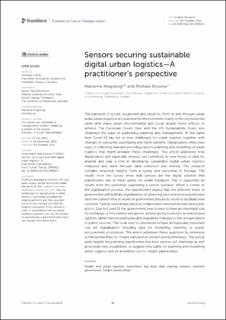| dc.contributor.author | Knapskog, Marianne | |
| dc.contributor.author | Browne, Michael | |
| dc.coverage.spatial | Norway, Oslo | en_US |
| dc.date.accessioned | 2023-06-16T09:07:46Z | |
| dc.date.available | 2023-06-16T09:07:46Z | |
| dc.date.created | 2022-10-06T16:08:50Z | |
| dc.date.issued | 2022-10-04 | |
| dc.identifier.citation | Frontiers in Future Transportation. 2022, 1-17. | en_US |
| dc.identifier.issn | 2673-5210 | |
| dc.identifier.uri | https://hdl.handle.net/11250/3071753 | |
| dc.description | AUTHOR=Knapskog Marianne, Browne Michael. TITLE=Sensors securing sustainable digital urban logistics—A practitioner’s perspective. JOURNAL=Frontiers in Future Transportation. VOLUME=3. YEAR=2022. URL=https://www.frontiersin.org/articles/10.3389/ffutr.2022.993411. DOI=10.3389/ffutr.2022.993411. ISSN=2673-5210 | en_US |
| dc.description.abstract | The transport of goods, equipment and waste to, from, in and through urban areas (urban logistics) are essential for the economic vitality of the city but at the same time make urban environmental and social targets more difficult to achieve The European Green Deal and the UN Sustainability Goals also challenge the ways of addressing planning and management. At the same time Covid 19 has led to new challenges for urban logistics together with changes in consumer purchasing and travel patterns. Digitalisation offers new ways of collecting data and providing input to planning and modelling of urban logistics that might alleviate these challenges. This article addresses how digitalisation and especially sensors can contribute to new forms of data for analysis and play a role in developing sustainable digital urban logistics measures and plans through data collection and sharing. The research contains empirical insights from a survey and workshop in Norway. The results from the survey show that sensors are the digital solution that practitioners see as most useful for urban transport. This is supported by results from the workshop supporting a sensor scenario. When it comes to the digitalisation process, the practitioners expect that the different levels of government will facilitate digitalisation of urban logistics and most practitioners have the opinion that all levels of government should do more to facilitate new solutions Testing should take place as collaboration between private and public actors. Due to Covid 19 the government level is seen to have an important role for exchange of information and advice, and for giving economic incentives and support, rather than providing law and regulatory changes or the reorganisation of public services. The local level is considered to have an especially important role for digitalisation including data for modelling, planning or public procurement procedures. The article addresses these questions by reference to the partnerships for freight transport in London and Gothenburg. This article adds insights for planning practitioners into how sensors will challenge as well as provide new possibilities, to suggest new paths for planning and modelling urban logistics and an amplified role for freight partnerships. | en_US |
| dc.language.iso | eng | en_US |
| dc.publisher | Frontiers Media | en_US |
| dc.rights | Navngivelse 4.0 Internasjonal | * |
| dc.rights.uri | http://creativecommons.org/licenses/by/4.0/deed.no | * |
| dc.subject | freight and urban logistics | en_US |
| dc.subject | transitions | en_US |
| dc.subject | big data | en_US |
| dc.subject | data sharing | en_US |
| dc.subject | sensors | en_US |
| dc.subject | network governance | en_US |
| dc.subject | freight partnerships | en_US |
| dc.title | Sensors securing sustainable digital urban logistics—A practitioner’s perspective | en_US |
| dc.title.alternative | Sensors securing sustainable digital urban logistics—A practitioner’s perspective | en_US |
| dc.type | Journal article | en_US |
| dc.type | Peer reviewed | en_US |
| dc.rights.holder | © 2022 Knapskog and Browne. This is an open-access article distributed under the terms of the Creative Commons Attribution License (CC BY). The use, distribution or reproduction in other forums is permitted, provided the original author(s) and the copyright owner(s) are credited and that the original publication in this journal is cited, in accordance with accepted academic practice. No use, distribution or reproduction is permitted which does not comply with these terms | en_US |
| dc.source.articlenumber | 993411 | en_US |
| dc.description.version | publishedVersion | en_US |
| cristin.ispublished | true | |
| cristin.fulltext | original | |
| cristin.qualitycode | 1 | |
| dc.identifier.doi | 10.3389/ffutr.2022.993411 | |
| dc.identifier.cristin | 2059321 | |
| dc.source.journal | Frontiers in Future Transportation | en_US |
| dc.source.volume | 3 | en_US |
| dc.source.pagenumber | 1-17 | en_US |
| dc.relation.project | Norges forskningsråd: 283332 | en_US |

